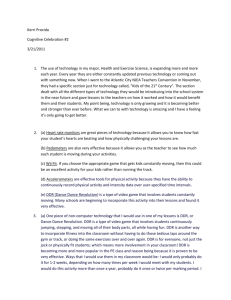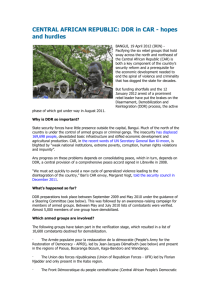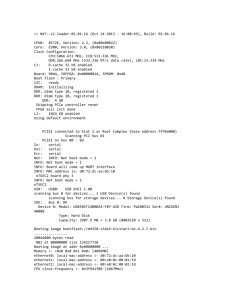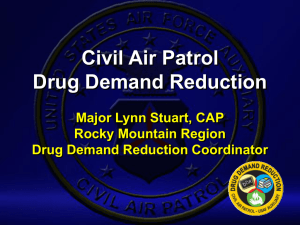DDR Form 1C - CAP Members
advertisement
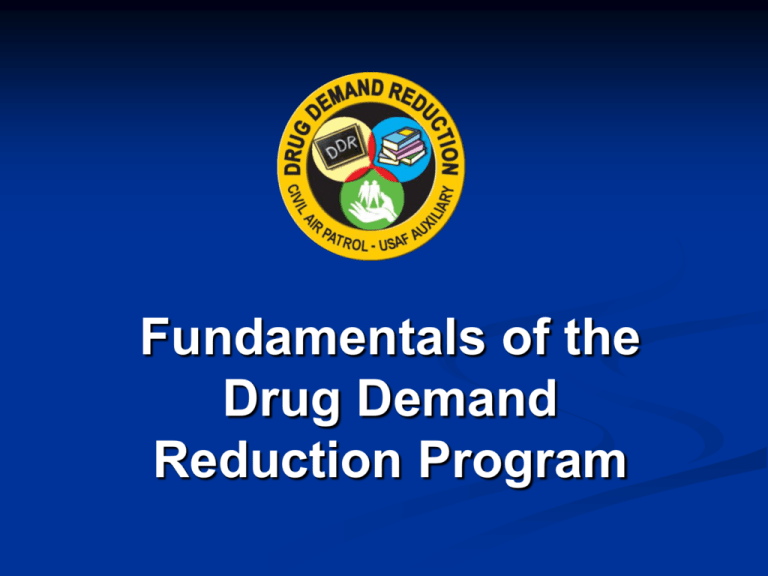
Fundamentals of the Drug Demand Reduction Program Program Overview Began in 1994 to support “The Air Force Family” within 30 miles of an Air Force Facility Expanded to include entire CAP organization with emphasis on the Cadet Program Focus has shifted from acquiring “stuff” to promoting DDR DDR Program Elements Training Education Community Outreach Education Increases knowledge and awareness of drug abuse/use through: - Substance abuse materials, classes, lesson plans, videos, games and promotional items - Partnerships with AF active duty, Reserve and National Guard DDR programs - Partnerships with local substance-prevention agencies/coalitions, Drug Enforcement administrators, FBI community outreach coordinators and state governor drug policy coordinators - Portable displays, drug kits, and fatal vision goggles to share the message and promote CAP Training Provides fundamental knowledge and competencies for DDR officers through: - Tele-training sessions (basic, funding, & activities) - Learning labs at the annual conference - Regional training for DDR coordinators & administrators - Wing training for units and cadets DDR officers Community Outreach Partners cadets with base and local activities to support anti-drug activities such as: - Red Ribbon Week Campaign - Drug Education for Youth (DEFY) - Military youth and teen programs - Family Community Centers - Community Health Fairs - Base-sponsored community activities Team DDR UNIT SUPPORT Coordinators: DDRC and C/DDRC (Region Level) Administrators: DDRA and C/DDRA (Wing Level) Officers: DDRO and C/DDRO (Squadron or Group Level) NHQ SUPPORT DDR Program Manager – Mike Simpkins DDR Program Administrator – Gretchen Clayson DDR Team Leader – Lt Col Jett Mayhew Strategic Goals Goal 1: Establish and maintain an active and productive DDR Program - Focuses on working relationships with local substance abuse prevention agencies and/or coalitions—active duty AF DDR Coordinators, AF Reserve DDR personnel, National Guard State DDR Administrators, FBI Community Outreach Coordinators, State Governor’s Drug Policy Coordinators, & Service (Army, Navy, Marine, and Coast Guard) DDR programs Goal 2: Establish and maintain DDR personnel throughout CAP - Focuses on keeping manning levels above: 85% for DDRCs, 90% for DDRAs and cadet assistance DDRAs, and 80% for DDRO and DDRO cadets Strategic Goals Goal 3: Increase awareness of substance abuse issues and its impact on the individual, community and the mission - Focuses on raising awareness of substance abuse issues thru involvement with community outreach efforts to include Red Ribbon Campaign, base-wide events, encampments, and coalition/agencies outreach activities Goal 4: Develop a financial plan consistent with the DDR vision and mission - Focuses on ensuring region/wing/squadron budget requests support the DDRP goals and objectives, per established funding/budget process and unit strategic plan Strategic Goals Goal 5: Measure program effectiveness - Focuses on providing the proper oversight mechanisms to track and measure program success—Community That Cares Youth Survey, After-Activity Reports, and other indicators that track program effectiveness Initiatives Revision of CAPR 51-1 Launch “FIT FOR FLYING” Implement “STARBASE” Partnership Support JROTC Drug Awareness Develop DDR Excellence Program Linking DDR with character development Finalize Quick Start Guide Automate End-of-Year report DDR Funding Process Overview Old/New Process Air Force Surgeon General Guidelines DDR Travel Funding Process • • Catalog Request Non-Catalog Requests Forms Review “Simple enough for a child” stated the instructions with great audacity. Why don’t they give me a break once in a while and reduce them to my capacity. Maxine Brewer Funding Process OLD PROCESS Submit Annual Request Obtain Quotes from Multiple Vendors Wait months for Approval Order from multiple vendors All Reimbursements at 80% All Reimbursements via CAPF 108 NEW PROCESS Submit Requests based on Activity Approval from NHQ usually less than 48 hours DDR Catalog (Shipping cost only) • Promotional Items • Education and Training • Fatal Vision Goggles • Model Rocketry (Community Outreach only) Non DDR Catalog Items (80-20 split) Air Force Surgeon General Office Guidelines Congressionally mandated funds but not part of the annual CAP appropriation Assists units in instilling aggressive, positive, drug-free attitude in CAP members (seniors and cadets), Air Force families, DoD civilians, and school-aged children located within 30 miles of an Air Force Base, Air Force Reserve Base, Air National Guard Base, or units with 100 or more Air Force personnel Products and services funded by the DDR Program must have direct application to the DDR Program goals and objectives DDR Program maintains program accountability in accordance with DoD Directives and AFMOA/SGOC guidance, and AFI 65-601V1, Budgetary Guidance and Procedures. Authorized Expenditures Direct administrative costs for DDR activities and events (i.e., paper, markers, printing, and other items not other wise provided by CAP) Travel costs for DDR Coordinators and Administrators to support training over 50 miles from their home of record Drug prevention literature and visual aids Promotional items Education and training materials Fatal Vision goggles Model rocketry materials to support community outreach activities to expand knowledge of both DDR and aerospace. This is not to supplement the normal model rocketry training Events and activities with a direct DDR connection Unauthorized Expenditures Computers, DVD players, and related items Uniforms and uniforms items Region, wing, state, and squadron flags Food, trophies, plaques, and honoraria Encampment or Membership Scholarships T-shirts, hats or other apparel Personalized DDR promotional items Office Equipment Federal Tax DDR Coordinator/Administrator Travel Travel more than 50 miles from residence to attend or deliver training at conferences, schools, encampments Submitted on CAP Travel Authorization Form no later than 3 weeks prior Covers expenses for transportation, meal and miscellaneous expenses Upon Completion, submit Travel Voucher within 20 days & After-Activity Report within 5 days Reimbursed at 100% Forms and instructions available at the DDR NHQ Website Wing Demographic Form Required for any wing requesting AFSG funding Submitted Annually unless significant change Identifies all units in the Wing– lists eligible units (<30 nm) and non-eligible units (>30 nm) DDR Catalog Accessed from NHQ DDR Website Four Categories • Promotional Items • Education and Training • Fatal Vision Goggles • Model Rocketry (Community Outreach only) DDR Form 1a used to request items (4-6 weeks prior to event) DDR Form 1c used for Sq/Wing/Region approvals DDR NHQ pays 100% for items. Units pay for shipping and handling only Ordering from Online Catalog http://members.gocivilairpatrol.com/drug_demand_reduction/links_to_ drug_demand_reduction_resources/ddr_catalog/index.cfm Promotional Items – Print Tex Education and Training - PSA Fatal Vision Goggles - Innocorp Model Rocketry – A.C. Supply Non-Catalog Items Promotional & Non-Promotional Items not listed in the Catalog -- Example: Administrative costs for DDR activities DDR Form 1b used to request items DDR Form 1c used for Sq/Wing/Region approvals Units pay 100% of costs upfront and are reimbursed at 80% using a CAPF 108 Reimbursement is made electronically to Wing/Region All reimbursement requests must be received no later than 30 days after the event/activity to receive reimbursement Completing & Submitting Forms DDR Form 1a – catalog items DDR Form 1b – non-catalog items DDR Form 1c – approval form DDR Form 1A •One DDR Form 1A for each activity • Copy item name and item number from Vendor website • DDR Connection must indicate how activity supports DDR Program DDR Form 1B DDR Form 1C (top) • Required for all DDR Form 1As and/or Form 1Bs • Can be used to summarize multiple forms • After proper signatures are obtained, the DDR Form 1C should be emailed, along with all Form 1As/1Bs NHQ/DDR DDR Form 1C (Bottom) CERTIFICATION: I understand that while this information represents a projection, I must request approval from National Headquarters prior to exceeding any line item expenditure within mission number assigned. All funded activities provide equal access and equal opportunity and does not discriminate on the basis of handicap, color, creed, or religion. I certify that all pertinent directions have been complied with and that this action is in accordance with the best interest of the CAP/DDR Program. Unit Charter No. XYZ-003 Signature of Requester Lt Col Making A. Difference Typed Name and Grade of Requester Lt Col Making A. Difference APPROVED Approved Signature of Flight/Squadron Commander Lt Col Support You Flight/Squadron Living Free Squadron Date 29Sep07 APPROVED Approved Signature of DDRA Lt Col I. M. Leader Wing XYZ Date 01Oct07 REVIEWED Recommended As is Signature of DDRC Lt Col Drug Free Region ZYW Date 02Oct07 APPROVED Approved Signature of Wing/Region Commander Col Support You Wing/Region XYZ Date 03Oct07 Six Step Process 1. 2. 3. 4. 5. 6. Unit develops activity request (s) based on their strategic plan using DDR Form 1A and/or DDR Form 1B and DDR Form 1C Unit sends request (s) to wing DDR Administrator DDR Administrator signs and forwards forms to Region DDR Coordinator After reviewing the forms for accuracy, the DDR Coordinator signs and returns to the DDR Administrator The DDR Administrator obtains the signature of the Wing/Region Commander on DDR Form 1C and forwards request/s to NHQ DDR NHQ/DDR reviews the unit activity submission (DDR Form 1A) and e-mails Activity Approval Number to the wing DDR Administrator and vendor (s) Requestor orders items from website or phone referencing the activity approval number Summary of Forms Wing Demographic Form--identifies units DDR Form 1A--catalog items DDR Form 1B--non-catalog items (80/20) DDR Form 1C--summary & approval for Form 1A/1B; approves funding for shipping CAPF 108--reimbursement of non-catalog items
